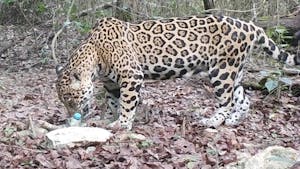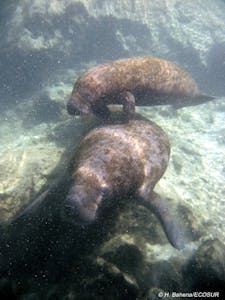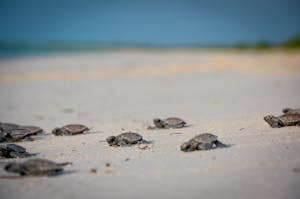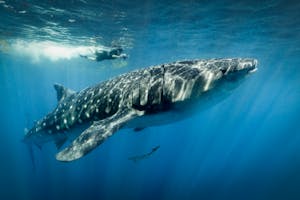Environmental Stewardship
Protecting Species and Ecosystems in Quintana Roo


Quintana Roo
Sac-Tun
International Division
Endemic, Threatened or Endangered Species
Habitat and Movements of the Jaguar in a Landscape Dominated by Humans in the Yucatán Peninsula, 2019-2021. Studies in Partnership with the Universidad Autónomo de Querétaro

The Yucatán Peninsula is home to an estimated 2,000 jaguars, almost half the entire jaguar population in Mexico. The majority of these magnificent animals live within the Mexican Caribbean Biosphere Reserve. In the preliminary phase of this part of our Environmental Strategy project, four jaguars have been photo-identified: two adult females, one adult male and one young male. Prey species important to their diet have also been identified. Several jaguars have been recorded crossing the federal highway, highlighting this particular serious risk to their health and safety. Since the information obtained was limited to the use of “camera traps”, we don’t yet have data regarding how the jaguars use the neighboring forests compared to the area being studied, nor do we yet know the frequency with which they cross the highway. This project will generate further information about the ecology of the jaguars in zones of anthropogenic influence in the Yucatán Peninsula, in addition to monitoring their movements using radio-telemetry and photo-identification as an aid in assessing habitat quality. Efforts will be undertaken to capture five jaguars in order to tag and monitor them for a year to determine home ranges, habitat use, movements, and the frequency of highway crossings. Jaguars captured will be examined to determine their general health, and samples will be taken to compare the results obtained with DNA stool testing. Information will also be compiled on other feline species and prey species within the area of study. All of this information will contribute to conservation of this iconic cat and its habitat.
Conservation Status of Manatees in Quintana Roo and Connectivity among Populations along the Coastal Zone, 2019-2021. Studies in Partnership with El Colegio de la Frontera Sur (Ecosur) – Chetumal.

Through regular aerial monitoring, information about the biology and ecology of the manatees in Quintana Roo will be updated, focusing primarily on spatial distribution, population size and coastal movements. Threats to the population due to tourism and marine developments along the coastal zone will be assessed, particularly at sites historically used by manatees. Twelve manatees will be captured and tagged with GPS transmitters along the coastal zone of the Protected Areas of Yum Balam, Sian Ka’an, Xcalak Reef National Park and the Manatee Sanctuary at Bahía de Chetumal. To help promote cooperation with local communities and the federal authorities responsible for coordinating the protected areas (CONANP), organized local groups, fishing cooperatives and institutions dedicated to manatee conservation will be involved in the capture and monitoring of the tagged manatees. At the end of the project, we will have baseline data regarding the abundance, spatial distribution and movements of manatees along the coastal zone of Quintana Roo, based on which we will recommend preventive measures to help protect manatees and their habitat in Quintana Roo.
Conservation of Critical Sea Turtle Nesting Habits, Connectivity and Population Parameters along the North-East Coast of the Yucatán Peninsula, 2019-2021. In Partnership with Pronatura Peninsula de Yucatán, AC.

For almost three decades, Pronatura Peninsula de Yucatán and numerous other partners have supported the conservation and protection of sea turtles along the north-east coast of the Yucatán Peninsula. This is an area of regional and international importance for the nesting of the hawksbill turtle and the green sea turtle, both endangered species. Given the longevity of these species (some more than 100 years), long-term studies are required to design and implement adaptive management and protection strategies. Through this project we will continue monitoring two turtle species on the beaches of Holbox Island to obtain information about the number of broods per year, hatching and emergence success rates, and the proportion of female neophytes during each season. With this information, population trends will be assessed to redefine conservation activities and propose adaptive management strategies where necessary. Through the genetic analysis of tissue samples, we will identify feeding grounds for female sea turtles who nest in the north-east portion of the Peninsula, in addition to ascertaining how each feeding ground contributes to the nesting sites. This information will help us better understand the connection between both areas, which is of fundamental importance in identifying and prioritizing zones for marine conservation.
Contribution to Sustainable Whale Shark Tourism Management in the Mexican Caribbean, 2019-2021. In Partnership with Pronatura de Peninsula Yucatan. 
The presence of whale sharks in the Mexican Caribbean has led to increased whale sightings and swimming activities in the presence of this, the largest of all sharks. This significant increase in human interaction along with a lack of information about whale shark response represents a potential risk to their populations and habitats. In 2016, Pronatura de Peninsula Yucatán created a proposal to estimate the capacity of whale sighting tourism activities, with whale abundance as the main parameter. However, this variable can vary greatly in terms of space and time, and there is also a lack of data for use with this methodology to help with the decision-making processes. This project will contribute to addressing these difficulties. By flying over the areas of aggregation, the number of whale sharks will be counted, in addition to accurately calculating the area used by tourist activities. Up-to-date and detailed information about whale sharks will be compiled, along with data regarding the area dedicated for tourism and the variables necessary for providing data for the mathematical model used to calculate tourism capacity. The effectiveness of the application of the model will be compared using data compiled each season. All of this information will support the federal environmental authorities in their efforts to improve the management of this species.
Priority Ecosystems and Sustainable Communities
Community Management and Conservation of the Aquifer and Cenotes in Maya Ka’an and the Mayan Riviera, Quintana Roo, 2019-2021. In Partnership with Amigos de Sian Ka’an, AC.
The newest tourism destination in Quintana Roo is Maya Ka’an. Its appeal is based on the cultural and natural wealth of this Mayan area, and it has been designed to directly benefit local communities by protecting natural resources. Maya Ka’an is home to the Sian Ka’an Biosphere Reserve, which is a UNESCO World Heritage Site, and the Sian Ka’an – Calakmul biological corridor. As part of this project, a sustainability model for tourism and community practices will be designed and implemented through sustainable management, environmental awareness, and water monitoring initiatives. To achieve this, technologies will be implemented to manage water resources in 22 communities in Maya Ka’an; the Eres Agua, Toma Conciencia education program will be offered to schools in Maya Ka’an and Playa del Carmen; cenote owners and users will be offered training in best conservation practices for the use of cenotes and their caves along the Yucatán Peninsula; and students from Mayan schools in Maya Ka’an and Playa del Carmen will receive training and equipment to monitor water quality in the wells and cenotes located in their communities.
Sustainable Fisheries through Community Partnerships along the Mesoamerican Reef System, 2019-2021. In Partnership with Comunidad y Biodiversidad, A.C. (COBI).
Fishing communities along the Mesoamerican Reef System contribute to the sustainability of Mexico’s fisheries and are important to the local economy and way of living. For example, 245 tons of spiny lobster, with a value of USD $4.4 million, are fished every year by six cooperatives located in the central-southern region of the State of Quintana Roo. These cooperatives are considered sustainable, according to international standards, but deal with the challenges of development and population growth. The fishing of Caribbean grouper, once a major source of income for local communities, has declined to the point of now being an endangered species. Since 2012, these six cooperatives, as part of a conservation and management strategy, have pioneered efforts with “fishing sanctuaries” to help protect coral reefs and spawning grounds of the Caribbean grouper. Despite such efforts, local and global short- and long-term changes are affecting these resources and communities. Through this project, COBI, in conjunction with more than 250 fishermen from the cooperatives, will take part in citizen science programs for the monitoring of the coral reef ecosystem. In addition, the project will focus on understanding social and ecological connections through the use of technology to help them adapt to environmental and social challenges. By the end of the project, 75 fishermen will have compiled data regarding the socio-ecological connectivity of two of the region’s most important species (lobster and grouper), 45 fishermen and women will have monitored 16 fishing sanctuaries and 10 commercial fishing spawning grounds, and the fishing communities will have co-designed strategies to adapt to environmental changes, such as the seasonal influx of sargassum and climate change, to help ensure sustainable fishing. This project will make an important contribution to the management plans for the spiny lobster and grouper in the Yucatán Peninsula, and the management programs for several protected natural areas: the Cozumel Island Flora and Fauna Protection Area, the Cozumel and Xcalak Reef Parks, and the Sian Ka’an, Banco Chinchorro and Gran Caribe Mexicano Reef Reserves.
Public Policy Development for Conservation Areas in the State of Quintana Roo, 2019-2021. In Partnership with Instituto de Biodiversidad y Areas Naturales Protegidas del Estado de Quintana Roo (IBANQROO) and the Secretaria de Ecologia y Medio Ambiente (SEMA), Quintana Roo
Quintana Roo is home to a wide range of diversity, in its forests, wetlands, and marine areas. In this ecosystem transition zone, the state government has created 10 protected natural areas covering 312,860 hectares (773,094 acres), encompassing Nature Reserves, Urban Parks, State Reserves and Conservation Zones. In 2018, the Quintana Roo Institute for Protected Natural Areas and Biodiversity was created to consolidate the policy to protect and sustainably manage biodiversity and natural resources within the state. Through this program, we will collaborate in developing management plans, technical studies, and the projects and processes necessary to define the legal and strategic frameworks for the following conservation and sustainable developments areas: the creation of a Management Plan for Laguna de Bacalar State Park and the Laguna Chacmuchuch State Flora and Fauna Sanctuary and Ecological Conservation Zone (Benito Juárez-Isla Mujeres); the coordination of a public consultation process for the creation of the Puerto Morelos Wetlands State Park, the Majahual Wetlands (Othon P. Blanco), the Xcacel-Xcacelito Ecological Conservation Zone (expansion-Tulum), and a Social Feasibility Study for the creation of a protected areas in Laguna Bacalar.
Consolidation of the Laguna Manatí Protected Natural Area, Quintana Roo, 2019-2021. In Partnership with Instituto de Biodiversidad y Areas Naturales Protegidas del Estado de Quintana Roo (IBANQROO), and the Secretario de Ecologia y Medio Ambiente (SEMA), Quintana Roo.
The Laguna Manatí Protected Natural Area was created in 1999 to protect 233 hectares of wetlands and mangrove in the community of Puerto Juarez, located in the metropolitan area of Cancun-Isla Mujeres, and with a population of close to one million people. A critical objective was to ensure that water not properly treated does not reach the lagoon, putting its water quality at risk along with that of the Laguna Chacmochuch system (1,914 hectares). This area currently lacks any institutional presence or management program. Both urban and tourism activities, in addition to a lack of operations personnel, have led to serious problems, including open air landfills for urban and hazardous waste, natural and induced sedimentation, illegal logging of mangroves, illegal fishing and hunting of reptiles, and the rise of invasive exotic species. These problems extend beyond the area of influence, fragmenting the ecological connectivity of the Laguna Manatí – Laguna Chacmochuch system, and the obstruction of the system’s hydrological flows, specifically in the inter-urban Cancun-Isla Mujeres, Puerto Cancun and Puerto Juarez channels. Through this project, we will implement a participative planning strategy to coordinate biophysical and socio-economic studies and the environmental assessment necessary to formulate the management program. In addition, the project will conduct the preliminary biological monitoring, control and oversight, infrastructure and equipment activities, as well as forming a sub-committee from the relevant sectors to undertake technical studies that will form the basis for the planning model.
Massive Seasonal Influx of Sargassum along the Coasts of Playa del Carmen and Quintana Roo
Considering the economic, social and environmental impacts of the seasonal influx of sargassum at the local, state, regional and national level, Sac-Tun and its partners at the Environmental Strategy workshops in Playa del Carmen agreed that a working group should be set up to analyze the problem and support the authorities in finding solutions to this threat.